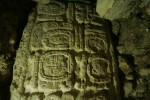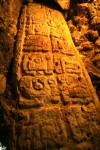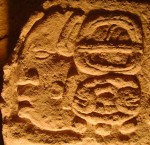 Excavations under the main temple of the royal Maya city of El Perú-Waka’ in northwestern Guatemala have uncovered a stela that adds a new chapter to our knowledge of Maya history. The engraved hieroglyphic text tells the story of two 6th century kings of the Wak or Centipede dynasty — King Wa’oom Uch’ab Tzi’kin (meaning “He Who Stands Up the Offering of the Eagle”) and his father King Chak Took Ich’aak (meaning “Red Spark Claw”) — and Lady Ikoom, a queen of the powerful Snake dynasty of Calakmul, none of whom were previously known to historians.
Excavations under the main temple of the royal Maya city of El Perú-Waka’ in northwestern Guatemala have uncovered a stela that adds a new chapter to our knowledge of Maya history. The engraved hieroglyphic text tells the story of two 6th century kings of the Wak or Centipede dynasty — King Wa’oom Uch’ab Tzi’kin (meaning “He Who Stands Up the Offering of the Eagle”) and his father King Chak Took Ich’aak (meaning “Red Spark Claw”) — and Lady Ikoom, a queen of the powerful Snake dynasty of Calakmul, none of whom were previously known to historians.
 The stela, officially dubbed El Perú Stela 44, was commissioned by King Wa’oom Uch’ab Tzi’kin around 564 A.D. in honor of his father who had died eight years earlier. For the first hundred years of its existence, the stela stood out of doors, exposed to the elements. Its hieroglyphics are worn from a century of erosion. Around 700 A.D., the stela was moved inside the main temple by order of King K’inich Bahlam II, probably as an offering for the funeral rites of his wife, the one, the only Lady K’abel, daughter of King Yuhknoom Ch’een the Great of the Calakmul Snake dynasty, Supreme Warrior of the Wak kingdom and Lady Snake Lord.
The stela, officially dubbed El Perú Stela 44, was commissioned by King Wa’oom Uch’ab Tzi’kin around 564 A.D. in honor of his father who had died eight years earlier. For the first hundred years of its existence, the stela stood out of doors, exposed to the elements. Its hieroglyphics are worn from a century of erosion. Around 700 A.D., the stela was moved inside the main temple by order of King K’inich Bahlam II, probably as an offering for the funeral rites of his wife, the one, the only Lady K’abel, daughter of King Yuhknoom Ch’een the Great of the Calakmul Snake dynasty, Supreme Warrior of the Wak kingdom and Lady Snake Lord.
 It’s likely that the king particularly prized the stela because as a scion of the Snake dynasty Lady Ikoom would have had a familial connection both to him and to his wife. Fragments of another stela, Stela 43, found in the walls of the temple last year also mention Lady Ikoom.
It’s likely that the king particularly prized the stela because as a scion of the Snake dynasty Lady Ikoom would have had a familial connection both to him and to his wife. Fragments of another stela, Stela 43, found in the walls of the temple last year also mention Lady Ikoom.
There is a gap in the region’s hieroglyphic record for more than a hundred years starting in the early 6th century at Calakmul and extending through 692 A.D. at Tikal. In Waka’, the gap starts in 554 A.D. and ends in 657. The stela is thus a unique source of information about the history of this “dark period,” shortening “The Hiatus” by a decade. It tells a riveting story of war and political intrigue.
The front of the stela … features a king standing face forward cradling a sacred bundle in his arms. There are two other stelae at the site with this pose, Stela 23 dated to 524 and Stela 22 dated to 554, and they were probably raised by King Chak Took Ich’aak. The name Chak Took Ich’aak is that of two powerful kings of Tikal and it is likely that this king of Waka’ was named after them and that his dynasty was a Tikal vassal at the time he came to the throne, the research team suggests.
The text describes the accession of the son of Chak Took Ich’aak, Wa’oom Uch’ab Tzi’kin, in A.D. 556 as witnessed by a royal woman Lady Ikoom, who was probably his mother. She carries the titles Sak Wayis, White Spirit, and K’uhul Chatan Winik, Holy Chatan Person. These titles are strongly associated with the powerful Snake or Kan kings who commanded territories to the north of El Perú-Waka’, which makes it very likely that Lady Ikoom was a Snake princess, Guenter argues.
“We infer that sometime in the course of his reign King Chak Took Ich’aak changed sides and became a Snake dynasty vassal,” [research director David] Freidel said. “But then, when he died and his son and heir came to power, he did so under the auspices of a foreign king, which [epigrapher Stanley] Guenter argues from details is the reigning king of Tikal. So Tikal had reasserted command of Waka’ and somehow Queen Ikoom survived this imposition.
“Then in a dramatic shift in the tides of war that same Tikal King, Wak Chan K’awiil, was defeated and sacrificed by the Snake king in A.D. 562. Finally, two years after that major reversal, the new king and his mother raised Stela 44, giving the whole story as outlined above.”